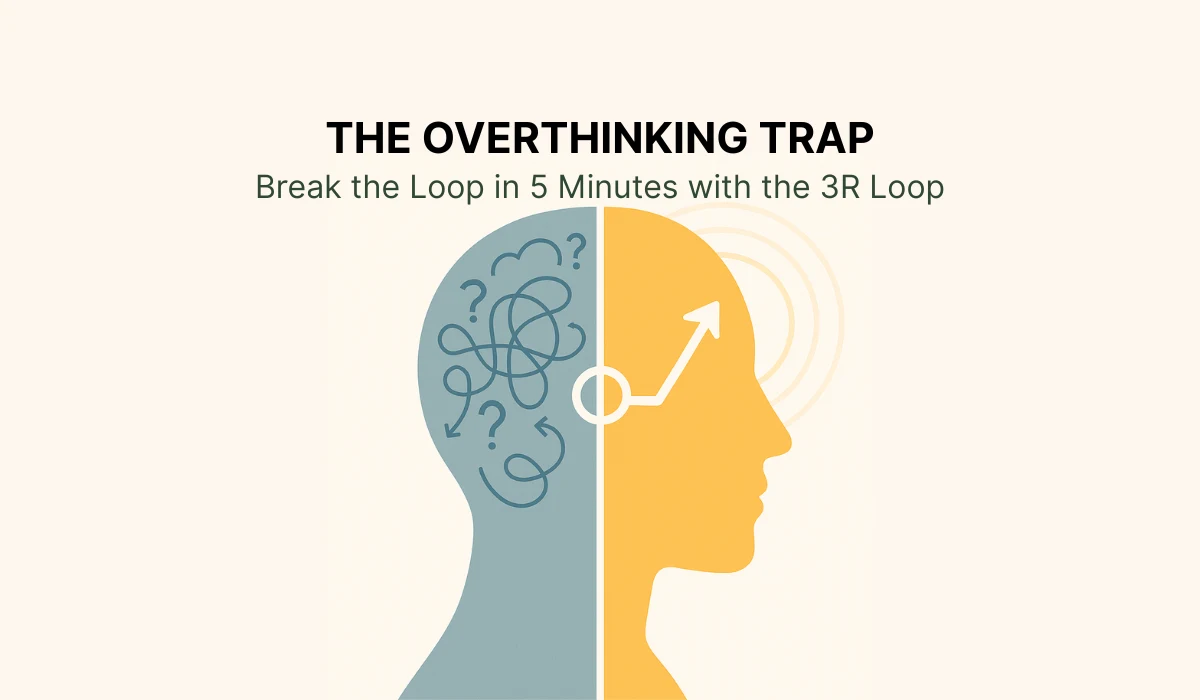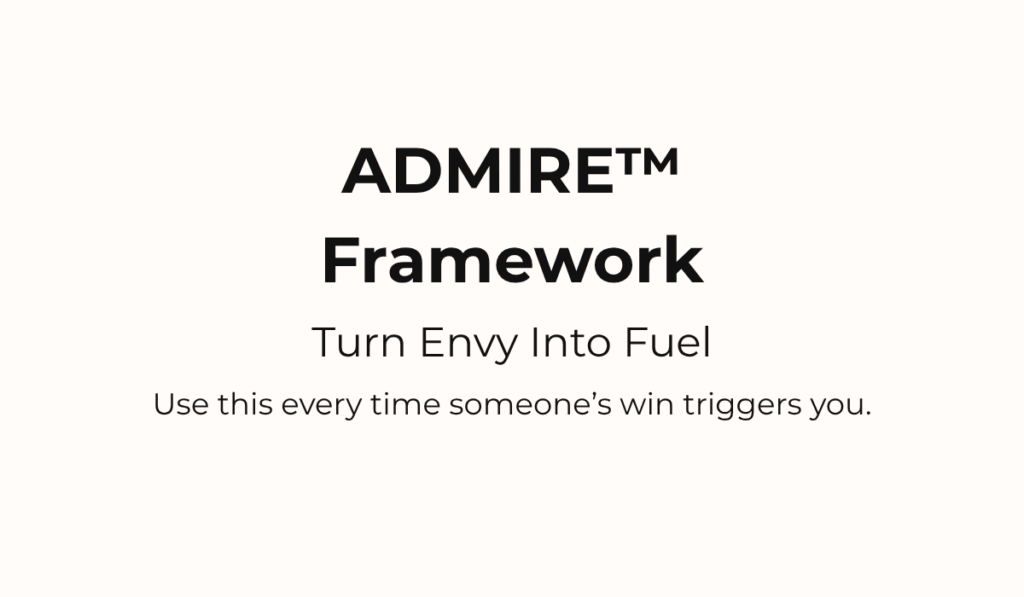Why Smart Minds Get Stuck in Endless Thinking Loops
What Is Overthinking?
Overthinking isn’t about confusion — it’s about control.
You replay scenarios, weigh every option, and try to predict every outcome until your mind feels stuck on a treadmill.
You don’t decide — you delay.
And every delay drains your energy, focus, and confidence.
It’s not a lack of intelligence.
It’s the overuse of it.
Why Overthinking Happens
- Too much information, not enough direction.
- Fear of regret or making the “wrong” choice.
- The pressure to be perfect instead of progressing.
Your brain tries to protect you by simulating outcomes — but ends up exhausting itself.
You’re not indecisive — you’re mentally overloaded.
Science says: writing down your thoughts reduces activity in the amygdala (the brain’s fear center).
Setting time limits reactivates the prefrontal cortex — the logic hub that brings calm and clarity.
Boundaries don’t restrict thinking; they restore it.
How the 3R Loop Was Born
During a product launch, my team debated one small feature for 11 days.
Charts, polls, calls — everything.
Every argument seemed logical. Every delay felt necessary.
By the time we moved, our competitor had already shipped.
We lost time, users, and energy — all because we thought too much.
That failure led to a simple realization:
When your brain spirals, you don’t need more time — you need a reset.
That’s how the 3R Loop was born.
The 3R Loop – Recognize. Reduce. Resolve.
A 5-minute mental clarity reset for overthinking.
1. Recognize the Loop
Catch yourself mid-spiral.
Ask: Am I analyzing — or just circling the same thoughts?
That small moment of awareness slows mental noise and reduces emotional overload by up to 30%.
2. Reduce the Load
Write down everything in your head — the options, fears, what-ifs.
When you put thoughts on paper, you free up mental space.
Your brain shifts from emotion-led to logic-led thinking.
3. Resolve with Boundaries
Set a 5-minute timer.
Define the worst-case scenario for each option.
Pick the one where the worst case is survivable.
Then decide — and move.
This isn’t impulsive decision-making.
It’s structured clarity under pressure.
A Simple Example
You’re stuck between two job offers.
One pays more. The other offers growth.
You’ve replayed the pros and cons ten times already.
Here’s how to apply the 3R Loop:
- Recognize:
“I’ve been circling the same thoughts all week. I’m stuck.” - Reduce:
Write both job titles. Under each, list 3 biggest worries and 3 biggest gains.
Now they’re visible — not swirling in your head. - Resolve:
Set a 5-minute timer.
Ask: Which job’s worst case can I live with?
If one’s worst-case scenario feels manageable (say, slower pay hike but better learning), choose it.
Decision made. Energy saved.
That’s clarity in motion.
A Daily Life Example
Overthinking doesn’t just happen at work.
It shows up in small choices too:
- Should I message that person or not?
- Should I skip the gym today?
Apply the same 3R approach:
Recognize the hesitation.
Reduce it to simple facts.
Resolve with a clear action.
Momentum creates clarity.
Why It Works
Overthinking isn’t an intelligence flaw — it’s a boundary flaw.
The 3R Loop resets those boundaries.
It turns endless thinking into timed thinking — a simple act of mental hygiene.
When used regularly, it builds a habit of calm, confident decision-making.
Science backs it too:
When your brain moves from amygdala-driven emotion to prefrontal-cortex reasoning, clarity replaces chaos.
Try It This Week
Use the 3R Loop once a day for any decision — small or big.
Track how often your quick decisions actually backfire.
You’ll find most don’t — they free you.
Progress doesn’t come from perfect decisions.
It comes from decisive ones.
Key Takeaways
- Overthinking is a boundary issue, not a lack of intelligence.
- The 3R Loop turns mental clutter into structured clarity.
- Clarity grows when you decide with limits, not fear.
The IntuiWell Advantage
At IntuiWell, we don’t teach you to stop thinking — we teach you to think with structure.
Our Personal Growth Program blends tools like the 3R Loop and ADF Model to help you manage mental noise, decision fatigue, and self-doubt — with measurable results.
Our clients report:
- 30–50% drop in mental clutter
- Sharper, faster decision-making
- Renewed confidence in daily choices
If your thoughts feel louder than your actions, you don’t need motivation — you need structure.
We’ve built one for you.
Explore IntuiWell’s Personal Growth Program
Blog Summary: The Overthinking Trap — How to Break the Loop in 5 Minutes
Overthinking isn’t confusion — it’s control gone too far.
Smart minds often get stuck replaying possibilities and predicting outcomes, draining focus and energy. The real issue isn’t a lack of intelligence but a lack of boundaries.
The 3R Loop — Recognize, Reduce, Resolve — is a 5-minute reset framework designed to turn endless mental spirals into structured clarity.
- Recognize the Loop: Catch yourself circling the same thoughts. Awareness reduces emotional overload.
- Reduce the Load: Write down everything cluttering your mind. Putting thoughts on paper frees mental bandwidth.
- Resolve with Boundaries: Set a timer, define the worst-case scenario, and decide within a set timeframe. Clarity comes from limits, not endless analysis.
This simple mental hygiene habit helps re-engage your logical brain (prefrontal cortex) and calm the fear center (amygdala).
From choosing between jobs to deciding whether to text someone, the 3R Loop works across life situations.
At IntuiWell, this principle forms part of our Personal Growth Program, helping individuals reduce mental noise, improve decision-making, and rebuild self-trust.
Because progress doesn’t come from perfect choices — it comes from decisive ones.
FAQs: The Overthinking Trap
Q1. What exactly is overthinking?
Overthinking occurs when your brain repeatedly replays the same scenarios and possible outcomes, attempting to avoid mistakes or regret. It’s not about confusion — it’s about seeking control, which eventually drains mental energy.
Q2. Why do smart people overthink more?
Highly analytical minds process more data and anticipate more outcomes. Without boundaries, that strength turns into a loop — too much information and too little direction.
Q3. What is the 3R Loop?
The 3R Loop stands for Recognize, Reduce, Resolve — a 5-minute mental reset that helps you break overthinking cycles and make confident decisions quickly.
Q4. How does writing down thoughts help reduce overthinking?
Writing reduces activity in the brain’s fear center (amygdala) and activates the logical prefrontal cortex, helping shift from emotion-led thinking to rational decision-making.
Q5. Can the 3R Loop be applied to small daily choices?
Yes. It works for both big and small situations — from job offers to everyday hesitations like sending a message or hitting the gym. The principle is the same: limit thinking time, act with structure.
Q6. Isn’t setting a 5-minute timer too restrictive?
Not at all. Boundaries don’t restrict thinking — they restore it. A short time frame forces focus and clarity, breaking the paralysis of analysis.
Q7. How often should I use the 3R Loop?
Try it once daily for any decision you tend to overthink. Over time, you’ll develop faster, calmer decision-making habits.
Q8. What is IntuiWell’s Personal Growth Program?
It’s a structured framework designed to help you manage overthinking, decision fatigue, and self-doubt. It uses science-backed models like the 3R Loop and ADF Model to build clarity, structure, and confidence in your thinking patterns.



